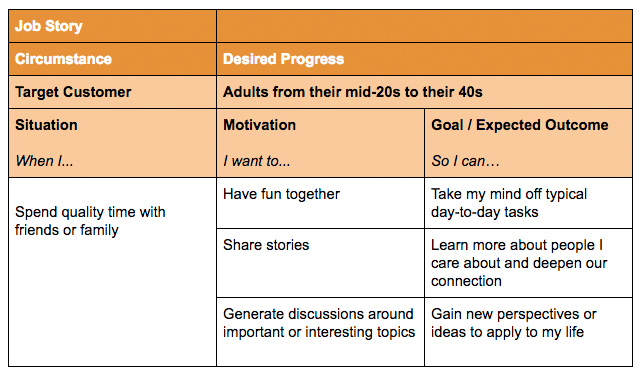
This series follows a real life startup to show how you can craft the strategy and messaging you need to launch your business idea and validate it with customers.
Quick Recap and Context
If you’re just jumping in, this series is designed to walk through a process to define the strategy and messaging for your business using the real life case study of a party game called The Death Deck. If you haven’t read that intro, it would be good to check that out first to get some context:
Read the intro to the series and the origin story of The Death Deck.
The steps being covered in this series are:
- Your Vision
- Your Target Customers’ Jobs [YOU ARE HERE!]
- Your Competition
- Your Offering and Its Features
- Your Tone of Voice and Messaging
If you’re all caught up and ready for the next step, let’s go!
Step 2: Your Target Customers’ Jobs
This step will help you define:
- The problem you’re addressing in your customer’s life
- What your customer values in a solution for this problem
Why it’s important:
Once you’ve established that zoomed out view of your Vision, the next step is to zoom in.
You need to get very specific about the problem you’re addressing in your target customer’s life.
This does not mean reverse engineering a problem to match your idea / solution.
Forget any notion of a solution — yours or anyone else’s. Just focus on people within the Vision you stated and what challenges they face in the realm of that topic.
To do this, we use a framework called “Jobs to Be Done”. In short, it’s identifying a “Job” your customers are trying to accomplish in their life and then some insights around why it’s important to them.
Jobs can relate to everything from small mundane daily tasks, to large emotionally driven or aspirational goals.

Some general examples of Jobs in people’s lives:
- Occupy my children when they get bored
- Spend my TV time on content that enriches my life
- Stay informed about topics I’m interested in during my commute
- Deliver a package from point A from point B
To help you discover the Jobs that people have related to the space you’re working in, there’s no substitute to talking to them. Hearing how people describe their challenges in their own words can help unlock ideas you won’t get on your own.
At a minimum, be sure to talk to people in your immediate circle. But if you’re willing to go the extra mile and feeling brave, you can try some guerrilla style interviews with folks on the street. Or you can look up phone numbers of businesses in your space and try to connect with folks that way.
The bottom line is that by talking to real people you’ll get a much better idea of what they struggle with and how they think about those challenges.
Exercise:
Through conversations with potential customers and your own brainstorming, create a list of Jobs related to the space you’re working in. Then, pick the most valuable Job(s) to expand into a “Job Story” where you’ll look at the underlying reasons why your Customer wants to satisfy them.
The Death Deck operates around the space of death and dying as well as around activities to do when you get together with friends and family.
Jobs related to the death and dying process:
- Prepare a will
- Get life insurance
- Learn the wishes of family members
- Understand the different options for someone when they’re approaching end of life
- Get new perspectives on beliefs of others around death and dying
- Support a friend who’s lost someone close to them
- Find ways to talk about a loss you experienced
- Connect with friends on a deeper level
Jobs related to spending quality time with friends / family:
- Have fun together
- Share stories
- Share thoughts on current events
- Discover new or different activities to do together
- Generate discussions around important topics
- Learn more about each others lives

Now let’s see how we can combine a few of the most important and frequent Jobs into a cohesive Job Story. Because The Death Deck is a party game, the core circumstance should be centered around people looking for things to do when they get together.

Key Takeaways:
Notice how this particular Job Story doesn’t directly mention anything about death and dying. It’s primarily focused on existing Jobs related to spending time together and deepening connections with people the customer cares about.
This helps illustrates the important separation between thinking about the problems and needs you’re addressing without connecting it directly to your solution (yet).
It’s good to create multiple Job Stories for your customers to explore the different aspects of what they’re seeking to accomplish in their lives.
Additional Job Stories for The Death Deck could, for example, go deeper on the experience of sharing experiences around a loss, whether it’s yours or someone close to you.
Ready For More?
In step three, we’ll show you how to look at the different competitors that are also seeking to address those Jobs in the lives of your customers. This will help you see where there are opportunities or challenges in the market.
Click here to get started on Step 3, Your Competition
Need Help?
If you ever get stuck on any of these steps you can get more free resources in our Field Guide.
And if you want help from us personally, you can reach out for a free consultation any time.
If you just want free stuff to help you think about your business in new ways sent to your inbox, sign up below!


